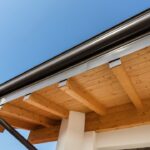Have you ever paused and wondered, ‘What are roof shingles made of’? It’s here that the journey into the fascinating world of roofing materials begins. Roof shingles are not only a vital component of our homes but also embody advanced technology that enhances both aesthetics and functionality. Understanding their composition, therefore, is essential for homeowners.
Roof shingles play a crucial role in safeguarding a house from weather elements, ensuring longevity and structural integrity. Recognizing the materials used in their construction unveils the secrets behind their resilience and popularity.

Building Blocks: The Core Materials of Roof Shingles
At the heart of every shingle lies the choice of material, each offering distinct advantages and aesthetics. There are several types of roof shingles, each made from different materials:
1. Asphalt Shingles
Asphalt shingles are arguably the most popular roofing material. Made of fiberglass mat or organic mat combined with asphalt and minerals, these shingles offer both durability and affordability. Their ability to withstand diverse climatic conditions makes them a go-to choice for many.
2. Wooden Shingles
Wooden shingles or shakes offer a natural and classic look. Typically made from cedar, redwood, or pine, these shingles provide excellent insulation and boast a unique rustic appearance. However, they require more maintenance compared to asphalt options.
3. Metal Shingles
Metal shingles are crafted from materials like steel, aluminum, or copper. These shingles are lightweight yet strong and flame-resistant. Their longevity and energy efficiency make them an increasingly popular choice among homeowners. For more insights, you can explore information on roofing materials.
4. Slate Shingles
Slate shingles are made from natural stone, offering a refined and elegant look to any home. These shingles are known for their longevity and can last over a century if maintained properly. Their weight and cost, however, may not be suitable for every home.
5. Tile Shingles
Originally popular in Mediterranean-style homes, tile shingles are made from clay or concrete. These heavy shingles are well-known for their ability to withstand severe weather conditions and add a distinct aesthetic value to homes.
Energetic Advances: Latest Technology in Roof Shingles
The world of roof shingles isn’t stagnant; it’s constantly evolving to meet environmental and aesthetic demands. With climate change and sustainability becoming focal points, the shingles industry has embraced technological advancements. The following innovations are at the forefront:
1. Solar Shingles
Solar shingles have emerged as a tremendous blend of technology and sustainability. They serve dual purposes: protecting the home and harnessing solar energy. Though their initial cost may be high, they offer huge energy savings in the long run.
2. Cool Roof Shingles
Cool roof shingles are designed to reflect more sunlight and absorb less heat. Utilized in energy-efficient homes, these shingles reduce cooling costs and improve indoor comfort. Their popularity is tremendous and growing.
Environmental Considerations and Sustainability
Modern homeowners are increasingly considering the environmental impact of their choices. When selecting roof shingles, sustainability is a significant factor. Let’s look at the eco-friendliness of various shingle options:
1. Recyclability
Recyclability has become a crucial aspect of roofing materials. Metal, slate, and some asphalt shingles are recyclable, reducing waste and environmental impact.
2. Impact on Energy Consumption
The energy efficiency of solar and cool roof shingles directly affects a home’s energy consumption. These shingles help lower energy bills and reduce carbon footprints, aligning with sustainable living goals.
The Tremendous World of Roof Shingles: Delighted with Diversity
The variety in roofing options should delight every homeowner. The blend of styles, colors, and materials available allows you to achieve your ideal home’s aesthetic without compromising functionality. Whether you choose the affordability of asphalt, the rustic charm of wood, or the enduring elegance of slate, you are investing in your home’s future.
External Factors Affecting Shingle Choice
When contemplating roof shingles, consider environmental factors and lifecycle costs to make an informed choice. For more guidance on choosing the right roofing materials and company, explore this guide.
1. Weather Conditions
Your local climate significantly influences your choice of shingles. Roofs in regions with extreme weather conditions demand durable solutions like metal or slate shingles.
2. Architectural Style
Your home’s architectural style is another determinant. While tile shingles are perfect for Mediterranean-style homes, asphalt shingles suit modern styles.
3. Cost and Value
Balancing cost and value is key. While some shingles may incur higher upfront costs, their longevity and energy efficiency can result in substantial savings. Consider these aspects when making your choice.
Keeping Roof Shingles in Peak Condition
Regular maintenance is vital. By conducting routine inspections and cleanings, you can ensure your roof shingles stay in optimal condition, extending their lifespan and enhancing their performance.
FAQs about Roof Shingles
1. How do I choose the right shingles for my home?
Consider your climate, budget, and architectural style. Weigh the benefits of different materials before making a decision.
2. Are roof shingles environmentally friendly?
Many shingles are made from recycled materials and can be recycled themselves, making them an environmentally conscious choice.
3. What’s the lifespan of different roof shingles?
Lifespan varies by material. Asphalt shingles last 15-30 years, metal shingles 40-70 years, slate over 100 years, and wooden shingles 30-50 years.

Conclusion
Understanding ‘what are roof shingles made of’ equips homeowners with the knowledge to make informed, sustainable choices that enhance their home’s longevity and curb appeal. By exploring the types and technologies behind these materials, you can ensure your home is not only protected but also aligned with your aesthetic and environmental values. For further guidance, don’t hesitate to consult roofing professionals for tailored advice.
For cost-related information, you may find resources like this article helpful.
This article contains affiliate links. We may earn a commission at no extra cost to you.








